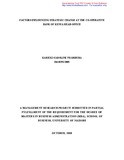| dc.description.abstract | Strategic Change means changing the organizational Vision, Mission, Objectives and of
course the adopted strategy to achieve those objectives (Jeff, 2007). Because the performance of firms might dependent on the fit between firms and their external environments, the appearances of novel opportunities and threats in the external environments, in other words, the change of external environments, require firms to adapt to the external environments again; as a result, firms would change their strategy in response to the environmental changes. The states of firms will also affect the occurrence of strategic change. For example, firms tend to adopt new strategies in the face of financial distress for the purpose of breaking the critical situations. Additionally, organizations would possess structural inertia that they tend to keep their previous structure and strategy (Jeff, 2007). This paper investigated the factors influencing strategic change at the Co-operative Bank head office. The paper consequently aimed to address the following research question: “What factors influence strategic change at the Co-operative Bank head office?” A case study of the Cooperative Bank of Kenya head office was undertaken focusing on fourteen (14) senior managers holding the following offices: the Managing Director & CEO; Internal Audit; Risk Management; Press Secretary/Personal Assistant; Merchant & Investment Banking; Treasury; Cooperatives Banking Division; Retail Banking Division; Corporate & Institutional Banking Division; Credit Management Division; Finance & Administration; Operations Division; Company Secretary; and, Human Resources Division. The study conducted interviews in order to collect primary data from the fourteen (14) office holders. However, only ten (10) of the respondents were interviewed. The data was then analyzed using content analysis and the information was then systematically presented using tables. The Research findings illustrated that content issues and context issues, especially the internal contextual environment are part of the factors that influence strategic change at Cooperative
Bank’s head office. Findings also illustrated that most internal environmental
factors were influential, especially, the bank’s human resource, strategic plan, financial
For evaluation only, resource and organizational culture. External environmental factors that were found to influence strategic change were both the economic and environmental factors. Consequently, the researcher recommended that the management at the Co-operative Bank of Kenya looks into both the content and the internal contextual issues and come up with effective strategies on the implementation of strategic change at the bank’s head office. An informed choice between fundamental and incremental change should also be made based on the organizations SWOT and PESTLE analysis. It is also strongly recommended that the top management involves all the departments within the bank’s head office in the implementation of strategic change. This would ensure that the process is owned by all the managers (change agents) and that effective monitoring and evaluation is undertaken from all the departments within the organization. | en |

